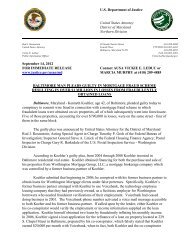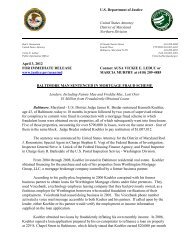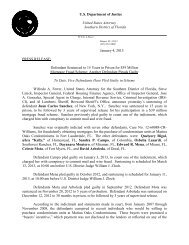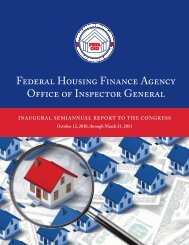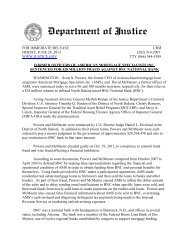FEDERAL
Sixth Semiannual Report to the Congress - Federal Housing ...
Sixth Semiannual Report to the Congress - Federal Housing ...
- No tags were found...
You also want an ePaper? Increase the reach of your titles
YUMPU automatically turns print PDFs into web optimized ePapers that Google loves.
Section 3: Lessons for Housing Finance Reform:<br />
Five Years After the Federal Government’s<br />
Takeover of Fannie Mae and Freddie Mac<br />
Introduction<br />
Five years have passed since the enterprises entered<br />
conservatorships in September 2008, where they<br />
still remain. In the meantime, Congress continues<br />
to consider the future of the secondary mortgage<br />
market and what, if any, role the government should<br />
play in it. 98 As policymakers deliberate, we offer this<br />
discussion, which draws on our experience, of three<br />
factors that are important to a safe, stable, and liquid<br />
mortgage market—whatever its ultimate structure. 99<br />
• First, soundness. The recent housing crisis<br />
has shown that, at minimum, the secondary<br />
mortgage market needs quality underwriting,<br />
robust risk assessment, and market-aligned<br />
servicing.<br />
• Second, oversight. Our work demonstrates that<br />
effective housing finance oversight requires wellequipped<br />
regulators to verify decision making<br />
and to enforce compliance.<br />
• Third, balance. Whatever the future mortgage<br />
market’s structure, participants will have to find<br />
a balance among interrelated laws, roles,<br />
and practices.<br />
Below, we discuss how these factors bear on housing<br />
finance. Our goal is not to take sides but to provide<br />
our stakeholders—FHFA, Congress, policymakers,<br />
and the public—with information that will be useful<br />
during the debate on housing finance reform.<br />
Context: Reforms and Reformers<br />
Historically, the enterprises have facilitated the flow<br />
of mortgage credit by purchasing mortgages from<br />
lenders, who, in turn, are freed up to make more<br />
mortgage loans. 100 When the housing bubble burst,<br />
though, the enterprises became insolvent, which<br />
ultimately resulted in their entering conservatorships<br />
under FHFA’s supervision. Since then, the agency has<br />
worked to conserve and preserve their assets and to<br />
ensure that they follow prudent business practices.<br />
Initially, FHFA understood the conservatorships<br />
to be temporary while, in the Acting Director’s<br />
words, “Congress and the Administration could<br />
figure out how best to address future reforms.” 101<br />
As the conservatorships became more long term,<br />
the agency advised that it would continue to guide<br />
the enterprises to accomplish generally agreedupon<br />
objectives—restoring their financial fitness<br />
and reducing their market footprint—while not<br />
precluding any of the major enterprise reform<br />
proposals, which range from privatization to<br />
elimination.<br />
In July 2010, Congress responded to the nation’s<br />
recession with Dodd-Frank. This law contains<br />
several housing finance reforms that are intended<br />
to address practices that contributed to the housing<br />
boom, including reducing the risk of borrowers<br />
defaulting. 102 It also requires MBS issuers to retain<br />
credit risk in the assets they securitize, that is, to<br />
keep some skin in the game. 103 Although this law<br />
addressed some important problems that led to the<br />
housing crisis—lenders with little to lose loaning<br />
to borrowers with little to repay—it did not resolve<br />
other fundamental concerns, such as the appropriate<br />
role for the government in housing finance.<br />
In February 2011, the Administration published<br />
its vision of the government’s role in Reforming<br />
America’s Housing Finance Market. In general, the<br />
Administration argues for replacing the enterprises<br />
with the private market as the primary source of<br />
52 Federal Housing Finance Agency Office of Inspector General



